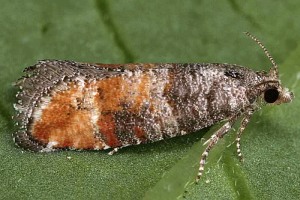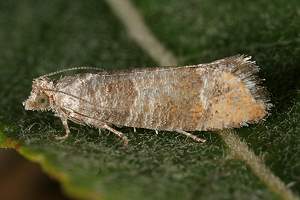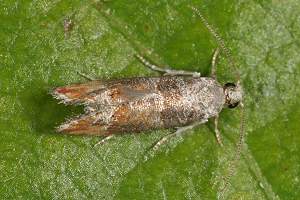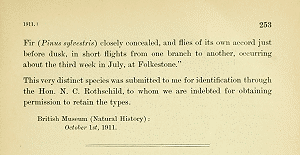

 +13Kontinente:EU
+13Kontinente:EU1. Lebendfotos
1.1. Falter
2. Diagnose
2.1. Männchen
2.2. Erstbeschreibung
3. Biologie
3.1. Habitat
3.2. Nahrung der Raupe
- [Pinaceae:] Pinus sylvestris (Wald-Kiefer)
- [Pinaceae:] Pinus contorta (Küsten-Kiefer)
- [Pinaceae:] Pinus nigra ssp. laricio (Korsische Schwarz-Kiefer)
Die Raupe ist an Kiefern gebunden. Hancock et al. (2015: 161-162) erläutern: "Ovum. Laid singly in August - September usually near the tip of a needle of Scots pine (Pinus sylvestris), lodgepole pine (P. contorta) or Corsican pine (P. nigra laricio); hatching in about 21 days. Larva. Body reddish brown. September - July; mines into a needle where it feeds until October and than hibernates; in spring recommences feeding within the needle and then on new growth, boring through the sheats into the needle bases; the needles are severed and fall and several pairs of needles may be thus destroyed; leaving empty leave sheats; the larva feeds entirely on the leaves and does not enter the buds or shoots; defoliation may cause shoots to die off on infested trees (Scott, 1972)." Die zugehörige Originalarbeit konnte ich noch nicht studieren.
(Autor: Erwin Rennwald)
4. Weitere Informationen
4.1. Andere Kombinationen
- Rhyacionia purdeyi Durrant, 1911 [Originalkombination]
4.2. Faunistik
Die Art ist im westlichen Europa verbreitet.
Hinsichtlich der Situation in Österreich bestand im Lepiforum zunächst Unklarheit. Bei Karsholt & Razowski (1996) wird die Art hier nicht für Österreich erwähnt, Razowski (2001) schreibt hingegen: „In Mitteleuropa nur aus Österreich und Deutschland bekannt.“ Die Angabe aus Österreich erfolgte dabei irrtümlich - die Art wird im Katalog von Huemer (2013) nicht erwähnt.
Nach Sauter & Whitebread (2005) ist die Art in die Schweizer Lepidopterenfauna aufzunehmen.
Huemer & Morandini (2009: 227) meldeten die Art neu für Italien (Dünen von Valle Vecchia).
(Autor: Erwin Rennwald)
4.3. Literatur
- Erstbeschreibung: Durrant, J. H. (1911): Descriptions of two new British species of Rhyacionia, HB. [Lep. Tin.]. — The Entomologist's Monthly Magazine 47: 251-253. London (Gurney & Jackson).
- Hancock, E.F., Bland, K.P. & J. Razowski (2015): The moths and butterflies of Great Britain and Ireland. Volume 5 (Part 2). Tortricidae, Olethreutinae. - 377 S.; Leiden & Boston (Brill).
- Huemer, P. (2013): Die Schmetterlinge Österreichs (Lepidoptera). Systematische und faunistische Checkliste. – 304 S. (Studiohefte 12); Innsbruck (Tiroler Landesmuseen-Betriebsgesellschaft m.b.H.).
- Huemer, P. & C. Morandini (2009): Biodiversity of Lepidoptera within the area of Valle Vecchia (Caorle, Venezia) with special regard to nature conservation aspects. Contributo alla conoscenza dei Lepidotteri dell'area di Valle Vecchia (Caorle, Venezia) con particolare riguardo agli aspetti conservazionistici. — Gortania – Atti Museo Friulano di Storia Naturale, 30: 221-254.
- Razowski, J. (2001): Die Tortriciden (Lepidoptera, Tortricidae) Mitteleuropas. Bestimmung - Verbreitung - Flugstandort - Lebensweise der Raupen. — 319 S.; Bratislava.
- Sauter, W. & S. Whitebread (2005): Die Schmetterlinge der Schweiz (Lepidoptera). 9. Nachtrag. — Mitteilungen der Schweizerischen Entomologischen Gesellschaft, Bulletin de la Société Entomologique Suisse, 78 (1/2): 59-115. [Digitalisat auf e-periodica.ch]
- Scott, T.M. (1972): The Pine shoot moth and related species. — Forest Record, London, 83: 1-14. [Sekundärzitat]

























